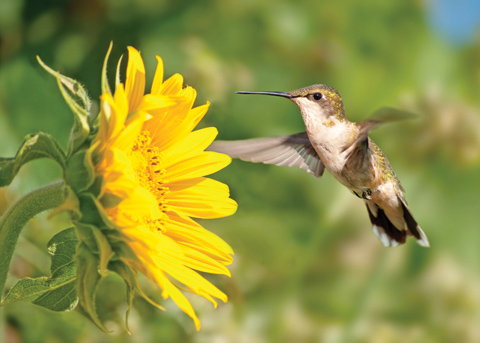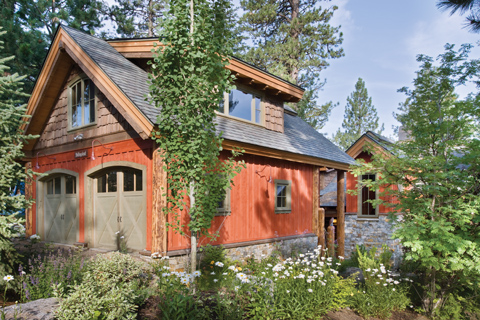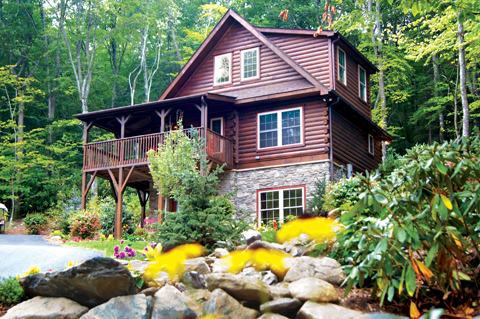The rustic charm of a log home is ideally suited to a natural garden that is in harmony with the surrounding environment. Creating a garden that not only adds beauty to the landscape but is also gentle on the earth is easy and inexpensive if you keep a few important principles in mind.
Why Eco-Friendly?
Homeowners are choosing environmentally sustainable gardening practices for a variety of reasons. “In some cases local and national government regulations are forcing a reduction in water and pesticide or herbicide use which causes people to look for alternatives,” says landscape architect Dale Nussbaum, of Nussbaum Group in Seattle, Washington. “In other cases, education about the health and environmental impacts of synthetic chemicals leads people to seek out ways that they can create a landscape that will support their goals.” For many log home owners, a love of the outdoors dovetails with their garden design choices. “What better way to provide a perfect setting for a log home than to have a landscape that weaves into its surroundings?” says Nussbaum.
Eco-Friendly Benefits
Gardens that are designed with the local environment in mind may be less expensive to create initially and are certainly easier on the wallet over the long term. By planting native plants, you’ll need less water and fewer (or no) chemical pesticides or herbicides. Your plants will remain healthy and thrive for a longer period of time. “All landscapes require a fair amount of work when new, but eco-friendly landscapes become self-regulating and, if planted correctly, provide plant cover that reduces weed growth while continuing to build healthy soil,” says Nussbaum.
Another facet is the wildlife that is attracted to a sustainable garden with native plants. “The greatest benefit is that you’re using climate-appropriate plants and plants that are indigenous to the area,” says Ramie Allard, owner of Blue Door Garden Design in Carmel, California. “That creates new habitats for wildlife. A garden is a place where things are supposed to happen—all the native birds and bees and even the critters under the surface that we don’t see,” she says. That cycle leads to healthier soil and a happier garden.

Earth First
To design an eco-friendly garden for your own home, look first at the big picture of your site. “The first thing in laying out a design is the topography and exposure to sun and wind,” says Allard. Track the sun’s path through each season, and make note of areas where you’ll want to take advantage of shade or make room for sun-loving plants. Also, think about how you intend to use your outdoor spaces. Will you be entertaining outdoors? Do you want a path to the water or lawn for the kids? “Who is living there? Pets, children, adults, elderly people—that can help guide your choices,” says Cheryl Buckwalter, owner of Landscape Liaisons Design in Cool, California. Consider whether you want a vegetable garden or want some color in the winter months.
The next step is to make sure you have healthy soil. “Nurturing the soil is so important,” says Buckwalter. “We’ve been educated that we have to feed the plant, but in reality if we take care of the soil the soil will feed our plants.” One of the biggest problems is compaction of the soil, especially on a home site that has been recently constructed.
Use organic compost suited to your local soil conditions to improve the quality of your soil. How do you know what nutrients your soil needs? “Each area of the country has different pH and nutrient levels,” says Nussbaum. “Take an inexpensive soil test and send it to the University of Massachusetts at Amherst for sampling—this will tell you what you need to do to create healthy soil from what you have.” Healthy soil requires fewer chemicals and holds moisture better, so you will use less water. And don’t forget about wood mulch. “That gives people the biggest bang,” says Buckwalter. “A good three-inch layer moderates the soil temperature, reduces weeds, and helps the soil retain moisture.
Think Locally
Plants that are native to your area are the best choice for an eco-friendly garden. Native plants will require less care and be easier to maintain because they are naturally suited to the climate where you live. Your local nursery is usually an excellent source for native plants, or talk to a master gardener in your area for ideas. “Use a diversity of plants,” says Buckwalter. “You want plants that are native to your region to attract pollinators and the various wildlife—butterflies and hummingbirds. You want to create food sources for them.”
Be patient while your plants mature. “Bigger plants usually come from out of your immediate area, so if you are very focused on an eco-friendly landscape, you may have slightly smaller plants at the beginning,” says Nussbaum. “Small plants grow in better and require less maintenance over time, so that may not be a bad thing!”
Bug Out
When you see bugs in your garden, don’t reach for the chemicals right away. Many insects are beneficial and provide food for birds and other wildlife in your garden. And those that are harmful to your plants? It’s easy to control them with—believe it or not—other bugs! “When you garden organically there are beneficial insects that come in,” says Allard. “We call it integrated pest management. The pests control each other.” Ladybugs, for example, will solve an aphid problem in no time—all without the use of harmful chemical pesticides.
Watch Your Water
The days of running a sprinkler for hours on end are over. Water conservation is important no matter what part of the country you live in. Native plants will be more tolerant of your water conditions. “I can create any kind of garden, but my job as a designer is to educate people that I can create the look they want and still use plants that are drought tolerant,” says Allard. Group plants with similar water needs together so you can create efficient “hydrozones.”
Even if you landscape with drought-tolerant plants, you’ll need to water regularly when they are first put into your garden. Use improved irrigation technology to help you water responsibly and efficiently. “Newer rotary nozzles put out multiple streams of water at a slower precipitation rate, so the soil has a chance to soak the water in,” says Buckwalter. You can use weather-based irrigation controllers or timers to regulate the amount of water you use; try to water early in the day to minimize evaporation. Don’t forget to check periodically for leaks or breaks in your irrigation system.


